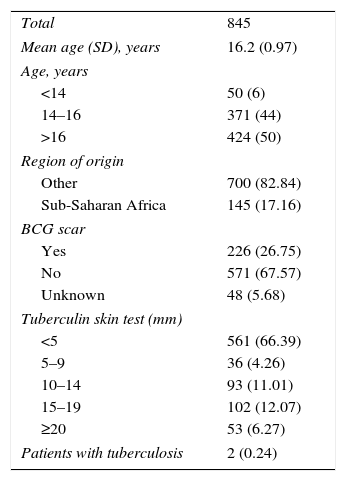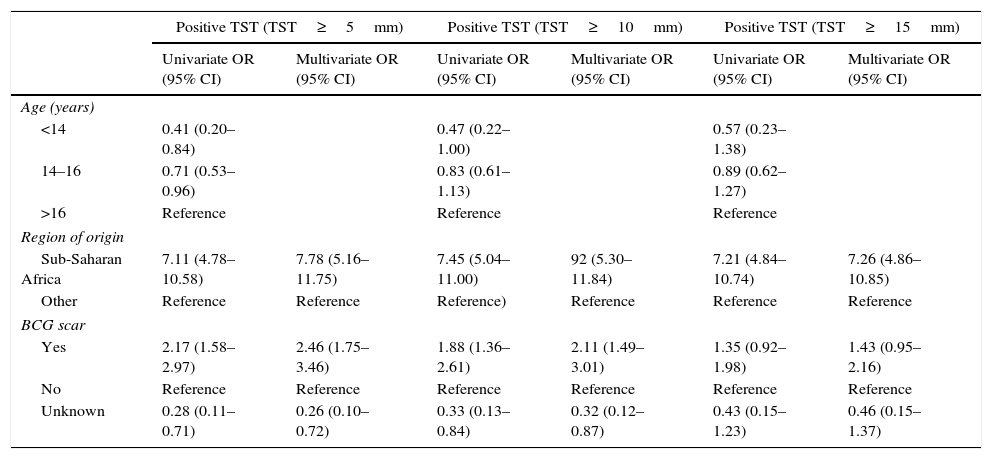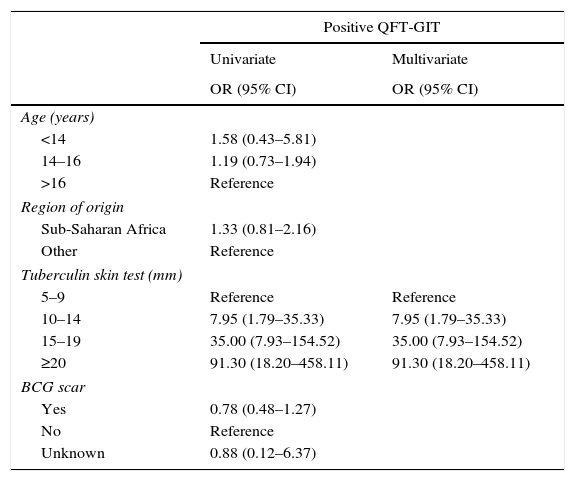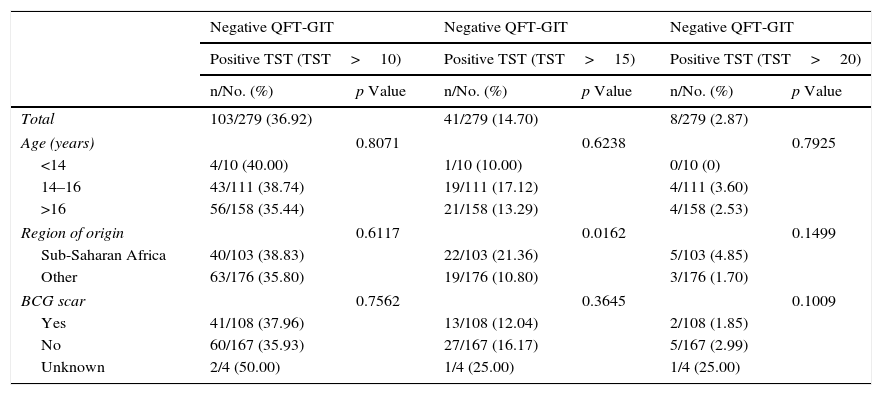The aim of this study was to determine the prevalence of tuberculosis infection in undocumented immigrant teenagers using a tuberculin skin test (TST) for initial screening and QuantiFERON®-TB Gold In-Tube (QFT-GIT) as a confirmatory test.
Patient and methodFrom 2007 to 2012, under 19-year-old immigrant teenagers from 2 accommodation centres of the Basque Country (Spain) were included in the study. The TST was done in all of them and the QFT-GIT was done in selected patients with a TST≥5mm.
ResultsEight hundred and forty-five immigrants were included, most of them from Africa (99.5%). Fifty-one percent of immigrants with TST≥5mm has a positive QFT-GIT. We found 2 cases of active tuberculosis (2/845: 0.24%). The concordance between TST (≥10mm) and QFT-GIT was 63%, with 57% of positive concordance cases and 96% of negative concordances. There were 246 cases with TST≥10mm (29%), with significant differences between Magrebis (21.5%) and Subsaharians (67%) (p<0.001). Vaccination with Calmette-Guéin bacille was an independent predictor for having a TST≥10mm (OR: 2.11; p<0.001) and for the discordance TST+/QFT-GIT−, both for a TST≥5 and a TST≥10mm (OR 2.16, 95% confidence interval [95% CI] 1.46–3.20, and OR 1.91 95% CI 1.23–2.97, respectively). The positive value of QFT-GIT increased significantly as the TST increased, with a positive association in all the cut-off points analysed: 10–14mm (OR 7.95, 95% CI 1.79–35.33), 15–19mm (OR 35, 95% CI 7.93–154.52) and ≥20mm (OR 91.3, 95% CI 18.20–458.11).
ConclusionDue to the high prevalence of latent tuberculosis infection in Subsaharian immigrants, we recommend implementing screening programmes in this population. Using QFT-GIT, the number of candidates for chemoprophylaxis was reduced to 43% compared with TST alone (≥10mm).
El objetivo de este estudio fue conocer la prevalencia de la infección tuberculosa en inmigrantes adolescentes indocumentados utilizando una estrategia con la prueba de la tuberculina (PT) para el cribado inicial y el QuantiFERON®-TB Gold In-Tube (QFT-GIT) como prueba confirmativa.
Pacientes y métodoSe incluyeron inmigrantes adolescentes recién llegados a 2 centros de alojamiento del País Vasco (España) entre los años 2007 y 2012. La PT se aplicó en todos los participantes, y el QFT-GIT, selectivamente en los reactores con una PT≥5mm.
ResultadosCompletaron el estudio 845 inmigrantes, mayoritariamente africanos (99,5%). Un 51% de los inmigrantes con una PT≥5mm fue QFT-GIT positivo, que corresponde el 17% de toda la muestra. Se encontraron 2 casos con tuberculosis activa (2/845: 0,24%). La concordancia entre la PT (≥10mm) y el QFT-GIT fue del 63%, con un 57% de resultados concordantes positivos y un 96% de concordantes negativos. Hubo 246 casos con PT≥10mm (29%), con diferencias significativas entre magrebíes (21,5%) y subsaharianos (67%) (p<0,001). La vacunación con el bacilo Calmette-Guérin fue un predictor independiente de tener una PT≥10mm (odds ratio [OR] 2,11, p<0,001) y de la discordancia PT+/QFT-GIT−, tanto para una PT≥5 como para una PT≥10mm (OR 2,16, intervalo de confianza del 95% [IC 95%] 1,46–3,20, y OR 1,91, IC 95% 1,23–2,97, respectivamente). La proporción de QFT-GIT positivo aumentó significativamente con el incremento de la positividad de la PT, con asociación positiva en todos los tramos analizados: 10–14mm (OR 7,95, IC 95% 1,79–35,33), 15–19mm (OR 35, IC 95% 7,93–154,52) y≥20mm (OR 91,3, IC 95% 18,20–458,11).
ConclusiónLa alta prevalencia de infección tuberculosa latente en los inmigrantes de origen subsahariano hace recomendable la implementación de programas de cribado en esta población. Utilizando el QFT-GIT se redujo en un 43% el número de candidatos a la quimioprofilaxis con arreglo a la PT (≥10mm).
Artículo
Comprando el artículo el PDF del mismo podrá ser descargado
Precio 19,34 €
Comprar ahora












